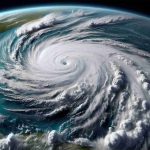The Role of Technology in Misidentified UFO Sightings
In an era defined by rapid technological advancements, the number of UFO sightings has reached unparalleled heights. CENAP, Germany’s UFO reporting hub, shared an astonishing revelation: 2024 witnessed over 1,000 UFO reports, significantly eclipsing past averages. This spike raises an eyebrow—not just towards the sky, but towards the technology many hold in their hands daily.
Technology’s Influence on Our Perception
The surge in UFO reports is largely linked to Elon Musk’s Starlink satellite program. These small satellites create captivating visual phenomena that are often mistaken for UFOs. While Starlink plays a significant role, everyday technology like drones and LED balloons adds to the confusion, creating bright displays that bewilder observers. Moreover, even celestial bodies like Venus and Jupiter contribute to the intrigue, thanks to their luminous presence in the night sky.
The Role of Smartphones and Social Media
With smartphones becoming powerful tools for capturing and sharing experiences, individuals are more likely to document these mysterious sightings. The viral nature of social media means these UFO-like occurrences gain rapid attention, piquing public curiosity and fueling debates.
Looking to the Future
As technology continues to evolve, public engagement with aerial phenomena is likely to escalate. This trend highlights the need for a discerning approach to understanding our skies. Scientists and technologists must collaborate to refine observation methods, ensuring that genuine scientific curiosity is not overshadowed by misidentification.
The fascination with UFOs, fueled by advancements in technology, suggests an exciting future where space exploration and public engagement converge, offering opportunities for deeper scientific understanding.
The Environmental Impact of Technological Misinterpretations in the Sky
In the contemporary landscape of constant technological innovations, the surge in misidentified UFO sightings has captured global attention. While these occurrences inspire wonder and speculation, they also bring significant implications for the environment, society, and the broader future of humanity.
Environmental Implications of Satellite Proliferation
The proliferation of satellite programs, such as Elon Musk’s Starlink, has not only transformed our communication systems but also impacted the night sky. These satellite arrays, often mistaken for UFOs, contribute to light pollution—a growing environmental concern. Light pollution disrupts ecosystems, affecting nocturnal wildlife navigation and altering predator-prey dynamics. Moreover, the reflective nature of these satellites compounds the issue, scattering additional light that interferes with astronomical observations.
Preserving the integrity of our night sky is essential for both environmental and scientific purposes. Scientists require dark skies for astronomy and other research, and the absence of natural darkness can have cascading effects on biodiversity. Efforts to mitigate light pollution and protect the environment might include international agreements on satellite brightness and controlled numbers of launches to strike a balance between technological progress and environmental stewardship.
Implications for Humanity and the Economy
The blur between reality and fiction introduced by technology affects not only individual perceptions but also societal dynamics. The heightened interest in UFO sightings underscores humanity’s longstanding curiosity about the unknown. This phenomenon fuels debates and indirectly contributes to economic sectors such as media, entertainment, and tourism, which capitalize on societal fascination with extraterrestrial life.
However, this fascination must be coupled with responsible education and critical thinking. As technology advances, it is crucial that humanity differentiates between scientific phenomena and optical illusions created by human inventions. Scholars, educators, and technologists must collaborate to teach discernment, ensuring that society remains informed and not swayed by misinformation.
Connections to the Future of Humanity
Looking forward, humanity’s relationship with the skies will only deepen. As we continue exploring space, the overlap between scientific discovery and public engagement has the potential to spark global participation in space-related initiatives. Public intrigue in aerial phenomena can catalyze funding for research, space missions, and innovations in observation technology.
In the future, we could see an era where individuals become active participants in scientific explorations, inspired by the mystery and beauty of our universe. Facilitating this integration could foster a more scientifically literate society capable of supporting sustainable and inclusive advancements. The key is to ensure that the excitement of the unknown is balanced with accurate information and acknowledgment of environmental implications, guiding humanity towards a harmonious coexistence with both technology and the natural world.
The Surprising Truth About UFO Sightings: How Modern Technology Shapes Our Views
Exploring the Impact of Modern Technology on UFO Sightings
In our era marked by rapid technological gains, the landscape of UFO sightings has transformed dramatically. New insights reveal how the convergence of advanced tech tools and the human psyche has contributed to a significant rise in reports of unidentified flying objects, reaching unprecedented levels.
The Digital Eye: Smartphones and Their Role
Smartphones have revolutionized how we document and interpret UFO sightings. Equipped with high-resolution cameras and instant internet sharing capabilities, these devices have made it easy for individuals to capture and distribute images and videos of unexplained aerial phenomena. While this leads to an increase in reports, it also raises questions about data authenticity and the role of digital manipulation.
Social Media: The Catalyst for Viral Mysteries
Platforms like Instagram, Twitter, and Facebook serve as modern-day amplifiers for UFO-related content. The viral nature of social media ensures that any sighting can gain global attention within minutes, blurring the lines between credible reports and sensationalized stories. This has further fueled public intrigue and varying levels of skepticism.
Fake or Not: The Challenge of Differentiating Truth from Optical Illusions
One significant factor in the rise of UFO sightings is the proliferation of drones and LED-based technologies. While these innovations serve legitimate purposes, their ability to mimic extraterrestrial crafts often leads to easily misidentified sightings. For instance, LED balloons can create captivating light patterns that appear otherworldly when misinterpreted by the untrained eye.
Light Pollution and Astronomical Bodies
Another often overlooked contributor is light pollution, which has altered public perception of celestial phenomena. Urban environments with excessive artificial lighting can distort the natural appearance of planets like Venus and celestial events, complicating efforts to discern genuine UFO observations from mundane occurrences.
Debunking the Mysteries: Pros and Cons
Pros:
1. Increased public interest in astronomy and science due to heightened UFO reports.
2. Expansion of technological literacy as more individuals use tech devices to document sightings.
Cons:
1. Difficulty in distinguishing authentic sightings from technological artifacts.
2. Potential for misinformation and panic fueled by viral, baseless claims.
Future Trends and Insights
As the tech landscape continues to evolve, public engagement with the concept of UFOs is expected to intensify. A future where cutting-edge space exploration intersects with mass public curiosity promises exciting possibilities for scientific exploration. This underscores the need for collaboration among scientists and technologists to create innovative observation tools and techniques that can accurately decipher the wonders of our skies.
For more insights into the role of technology and its influence across various domains, visit NASA.



















